-
Paper Information
- Next Paper
- Paper Submission
-
Journal Information
- About This Journal
- Editorial Board
- Current Issue
- Archive
- Author Guidelines
- Contact Us
Science and Technology
p-ISSN: 2163-2669 e-ISSN: 2163-2677
2012; 2(6): 146-151
doi: 10.5923/j.scit.20120206.01
Simulation of Levels of Noise Generated by Local Grinding Machnies Within the Community (A Case Study of Kaduna Metropolis, Nigeria)
Ali Haruna , Mn Agu
Department Of Physics Nigerian Defence Academy P.M.B 2109, Kaduna, Nigeria
Correspondence to: Ali Haruna , Department Of Physics Nigerian Defence Academy P.M.B 2109, Kaduna, Nigeria.
| Email: |  |
Copyright © 2012 Scientific & Academic Publishing. All Rights Reserved.
Levels of noise generated from grinding machines were measured. Noise levels as high as 116dB was obtained. These levels of noise can be stressful that can result to fatigue. It is capable of causing temporary and permanent deaf. Noise spectra generated from grinding machines are mixture of low and high frequencies. Low and high frequencies noise can have negative effects on memory. The levels of noise generated from these machines are very high and are above the international standard value. Critical investigations showed that some of these machines are old enough to be replaced, lack adequate maintenance and were poorly installed, thereby gave rooms for vibrations. Noise generated from these machines can result to quarrel in the neighbourhood since they are located within the community
Keywords: Noise Level, Temporary Deafness, Sensitivity, A-Weight, Machinery
Cite this paper: Ali Haruna , Mn Agu , "Simulation of Levels of Noise Generated by Local Grinding Machnies Within the Community (A Case Study of Kaduna Metropolis, Nigeria)", Science and Technology, Vol. 2 No. 6, 2012, pp. 146-151. doi: 10.5923/j.scit.20120206.01.
Article Outline
1. Introduction
- The ability of man to make and detect sound offers him the opportunity to communicate and receive valuable information from the environment, namely; sound alarm, music, television and others. Noise generated from industrial use of machinery, airplanes, trucks, pumps, turbines generator, steam traps and others should be differentiated from those of the community. The major sources of community noise are highway traffic, aircraft, construction work, and distribution of transformer, railway trains, and factories from which noise escape to the surrounding areas [1]. On noise studies, more emphasis is placed on the negative effects, that is, the pollution aspects. Noise can keep our senses on edge and thus can prevent us from relaxing. Our mental powers control this insults to our bodies resulting into deafness over a long period of time. Also as an insidious pollutant, damage is usually long range and permanent, yet it is certainly the pollutant of least public concern and perhaps the least understood [2].In most cases, especially in these studied sites the machines were almost located in front of residential houses or shops. There is no enough distance between the operators and the machines. There is direct transmissions and accumulations of noise doses to the operators.
1.1. Justification of the Work
- With the advent of modern technologies, noise pollution from instruments and machines and other technological advances like internal combustion engines, a bus or helicopter and aircraft in general have become a major threat to the quality of our lives. These instruments and machines are used by human beings, but various studies have shown that if the noise level is far in excess of that required for the optimum arousal level for a particular task, works become irritable as well as less efficient[3]. This irritability usually continues for sometime after the noise has stopped. Noise pollution is a global problem that is marked by the relentless inversion every corner of the world’s environment. The degree of the noise pollution is as a result of the frequent increase in sophistication of the machinery, which replaces manual labour in our industries. The noise produced by these industries varies according to their process technology, size, and nature of products, characteristics and complexity[4]. However, the resulting noise generation by this factory machinery at alarming level into the environment must not therefore be condoled, as it is an intrusion of unwanted nuisance. Scientific evidences available on noise pollution report the consequences of noisy environment as hazardous and detrimental to human health.
1.2. Effects of Noise
- When we are exposed to intense noise levels some or all of the hair cells in the organ of corti may be damaged temporarily or permanently. Exposure to excessive industrial noise for a short period of time may produce a loss of heavy sensitivity[5]. Temporary damage means that our hearing threshold level has shifted temporarily due to the noise exposure. Given adequate time for recovery in quieter environments, our hearing threshold returns to its original threshold level. Thus, a noise induced temporary threshold shift (NITTS) occurs.A noise induced permanent threshold shift (NIPTS) can occur from a catastrophic noise exposure such as a firecracker exploding close to one’s ear[6]. An injury of this type is called an acoustic trauma. When this occurs the organ of the Corti may be torn apart, or the structural damage to the inner ear may be so great that the hair cells soon die from the disruption.
1.3. Noise Classification
- The simplest means to specify the maximum tolerable background noise is to specify maximum acceptable A- weighted level[7]. As the A- weighted level stimulates the response to the ear at low levels, and has been found to correlate well with subjective response to noise, and such specification, this is often found to be sufficient. In 1991, the Federal Environmental Protection Agency, FEPA, Nigeria rated noise sources as low, moderate, high and very high, according to the following values: less than 80dB(A), between 81 and 90dB(A), between 91 and 100dB(A) and greater than 100dB(A), respectively (FEPA, 1991[4]. Specification such as 90dB (A) or less corresponds to 8hours exposure limits per day and is rated herein as moderate. Beyond this critical value of 90dB (A), is a threshold limit for the commencement of hearing damage.
2. Noise Power
- The integration of the acoustic intensity over the encompassing spherical surface is achieved by determining the time - average squared noise pressure at a discrete set of measurement points arranged uniformly. The noise power is calculated using the following equations,[8]
 | (1) |
 | (2) |
 Where T is the reference duration corresponding to the measured sound level and C is the total length of the working day in hours. The reference duration T is obtained using the equation:
Where T is the reference duration corresponding to the measured sound level and C is the total length of the working day in hours. The reference duration T is obtained using the equation: | (3) |
 | (4) |
3. Methodology
- In this work, measurement of noise pressure level were made using Sound Level Meter (Digital, Testo 816 ) and Digital Hand Data Logger (DB-525). The meter was mounted on tripod stand 1.5m high above the ground level and 3m away from the noise source in order to avoid recording the reverberant noise from other sources of noise. Measurements were performed at each measurement site by recording the noise pressure level at an interval of 10 minutes. Ten[10] readings were made at each noise source. The background noise was taken at every site when all the machines were switched off.
4. Results
- Noise SpectraThe plots of grinding machine noise as a function of frequency are shown in figures 1 to 6. (1) At Tudun Wada grinding machines, the noise intensity levels varies ranging from a minimum of 99dB at a frequency of 3,300Hz to a maximum of 109dB at a frequency of 1,800Hz for Atlas 3 hp, 79dB at a frequency of 1,800Hz for Vicking 2 hp and 101dB at a frequency of 200Hz to 109dB at a frequency of 2,400Hz for Mulan 3 hp (fig. 1).(2) At Kawo grinding machines, the noise intensity varies ranging from minimum a of 99dB at a frequency of 3,800Hz to 112dB at a frequency of 800Hz for Yamaha 5 hp, 112dB at a frequency of 2,800Hz to 116dB at a frequency of 4,800Hz for Mulan 6hp and 100dB at a frequency of 3,300Hz and 4,800Hz to 110dB at a frequency of 1,800Hz 3,800Hz for Vicking 3hp (fig. 2).(3) At Ungwan Rimi grinding machines, the noise intensity varies ranging from a minimum of 96dB at a frequency of 1,300Hz to 108dB at a frequency of 3,800Hz for Honda 5hp, 105dB at a frequency of 1,800Hz to 108 Hz at a frequency of 3,300Hz for Suzuki 5.3 hp and 100 dB at a frequency of 1,800Hz to 100dB at a frequency of 800Hz for Raja 6 hp (fig. 3).(4) At Malali grinding machines, the noise intensity varies ranging from a minimum of 101dB at a frequency of 500Hz to 109dB at a frequency of 800Hz for Honda 5 hp, 107db at a frequency of 4,800Hz to 110dB at a frequency of 2,400Hz for Mulan 6 hp and 102dB at a frequency of 4,800Hz to 112dB at a frequency 800Hz for Suzuki 5 hp (fig. 4).(5) At Kakuri grinding machines, the noise intensity varies ranging from minimum a of 103dB at a frequency of 2,800Hz and 4,400Hz to 109 at a frequency of 500Hz for Yamaha 5 hp, 101dB at a frequency of 4,800Hz to 111dB at a frequency of 500Hz and 3,300Hz for Atlas 5 hp and 105dB at a frequency of 1,800Hz and 2,800 to 112db at a frequency of 3,800Hz and 4,800Hz for Atlas 3 hp (fig. 5).(6) At Barnawa grinding machines, the noise intensity varies ranging from a minimum of 102dB at a frequency of 800Hz to 105dB at a frequency of 3,300Hz for Atlas 3 hp, 101dB at a frequency of 3,800Hz and 4,800Hz to 114dB at a frequency of 1,300Hz for Vicking 3 hp and 100dB at a frequency of 800Hz to 103dB at a frequency of 4,400Hz for Mulan 3 hp (fig. 6).
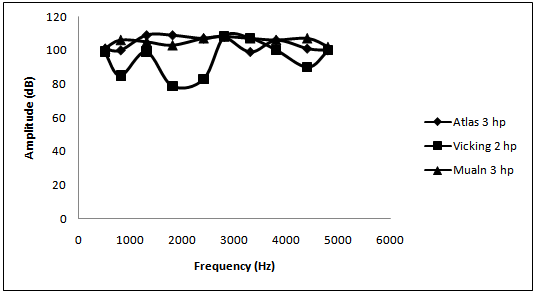 | Figure 1. Noise Spectra, Tudun Wada Grinding machine Noise |
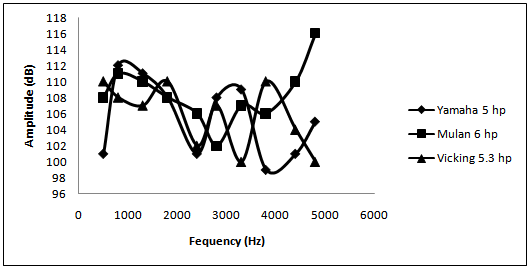 | Figure 2. Noise Spectra Kawo grinding machine Noise |
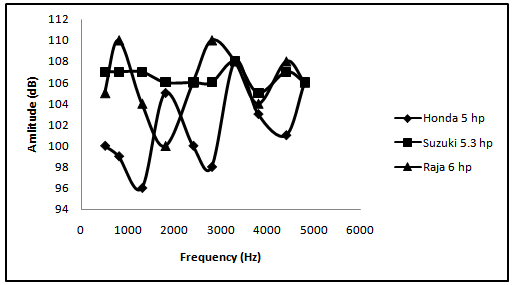 | Figure 3. Noise Spectra Ungwan Rimi Grinding machine |
 | Figure 4. Noise Spectra Malali Grinding Machine |
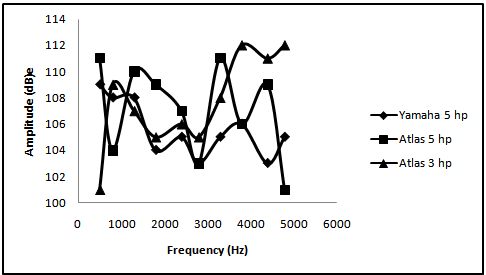 | Figure 5. Noise Spectra, Kakurii Grinding Machine |
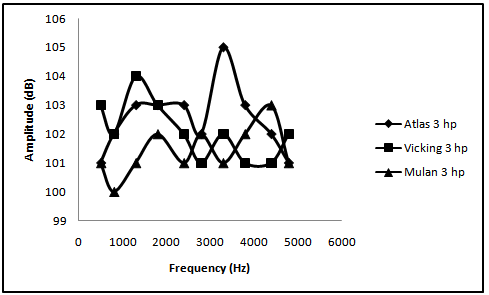 | Figure 6. Noise Spectra Barnawa Grinding Machine |
5. Analysis
- Figures 1-6, show that the noise generated by the machines is a mixture of low and high frequencies. Noise induced hearing loss can begin in frequencies other than the 3-6 kHz. There is always more loss at 3000Hz, 4000Hz and 6000Hz than at 500Hz, 1000Hz and 2000Hz. The greatest loss usually occurs at 4000Hz. The higher and lower frequencies take longer time to be affected than 3000HZ to 6000HZ range.Results above indicate that the noise levels generated by these machines are high above the international standard of 85 dB[12]The noise generated by these machines is characterized by a short duration, abrupt onset and decay, and high intensity. This type of noise is described as impulse noise. Exposure to impulse noise may result to temporary and permanent shifts in the threshold of hearing. Exposure to these levels of noise without intermittent would result to a lot of noise doses accumulated. Excessive and long exposure to these types of noise can put one on a health risk in that noise may contribute to the development and aggravation of stress related conditions such as high blood pressure, coronary disease, ulcers, colitis, migraine headaches etc.(9).The severity of noise induced hearing loss depends upon the noise levels to which the ear has been habitually exposed, the length of time of which it has been exposed to these levels, and the susceptibility of the individual. It is worth to note that the operators of these machines have little or no knowledge of the maximum noise level and duration of noise exposure. They operate throughout day. A significant factor that is known to increase noise induced hearing loss is continued exposure to hazardous noise or high level of noise (10). In addition, continuous noise exposure over a long period of time (years) is more damaging than interrupted exposure to noise, which permits the ear to have a rest and possibly recovery period. Powell and Forrest,[11] studied the effects of impulse noise from military weapons on long serving soldiers. They found that the continued strain led from temporary threshold shift to a permanent threshold shift. In the same manner, Admiral Rodney was reported to be deaf for a fortnight following continuous firing of eighty broadsides from the ship formidable in 1789[13]. At the battle of Copenhegan in 1801, an officer was also officially reported to have made permanently deaf from exposure to the discharge of cannons.The high levels of noise associated with the grinding machines are as a result of the following:(1) Poor installation of the machines: Some of these machines were poorly installed. Once the machine is not well balance on the floor or ground, vibration will occur which may result in the generation of noise when the machine is working.(2) Poor maintenance of the machines: irregular servicing of the machine may result in generation of high level of noise by the machine. Some parts of these machines need to be replaced periodically and once this is not done, rubs in rotating machinery prevents the shaft from moving or rotating in specified directions. Movement of parts of the machine in different directions level of noise.(3) Ageing of the machines: due to the ageing of the machine, parts of its components especially the casing become the major sources of noise. Some of the machines studied in this work are old enough to be out of use.Most of the machines that have been developed for industrial purposes, for high speed transportation, to make life more enjoyable by furnishing additional comfort, reducing the drudgery of everyday living and speeding up our daily routines, and to provide additional leisure hours are usually accompanied by noise. Such noise affects humans in a number of ways, like their hearing, their ability to communicate as well as their behaviors.When we are exposed to intense noise levels some or all of the hair cells in the organ of corti may be damaged temporarily or permanently. Exposure to excessive noise for a short period of time may produce a loss of heavy sensitivity. Temporary damage means that our hearing threshold level has shifted temporarily due to the noise exposure. Given adequate time for recovery in quieter environments, our hearing threshold returns to its original threshold level. Thus, a noise induced temporary threshold shift (NITTS) occurs. A commonly used classification of hearing impairment is based on the average permanent threshold shift for 500, 1000 and 2000Hz measured in the lesser impaired of the ear.Sudden and unexpected noise has been observed to produce marked changes in the body such as stress, fear, changes in pulse rate, respiration rate, blood pressure, metabolism acuity of vision, skin electrical resistance etc. Noise causes break in sleep. Irregular noise and noise which emerges from the background are particularly disturbing to sleep. Noise not leading to behavioral awakening can however produce psychological modifications which in certain cases (such as changes in the stages of sleep) can damage the quality of sleep[13].A comfortable environment is one, in which there is little or no annoyance and distraction so that working or leisure tasks can be carried out unhindered either physically or mentally. Unfortunately, environmental noise has become a serious problem in Kaduna metropolis, and it is difficult to regulate by physical means alone. It is well known that environmental noise may affect sleep, conversation and cause annoyance as well as affect task performance[14].
6. Conclusions
- The presence of low frequency noise can have adverse effect on concentration and memory. Fatigue is one of the most cited effects of low frequency noise. Low frequency noise is capable to increase cortisol values, which is an indicator of stress. Other physical effect attributed to low frequency noise include, peripheral vasoconstriction, elevated blood pressure and greater risk of cardiovascular disease. The best way of reducing the noise levels of the existing noise sources is to reduce the noise level at the source – path – receiver. At the source, the noise level can be reduced by balancing the rotating masses, reducing the motion of the vibrating components, changing in the usual procedure of operation (reducing or suspending operation at night[15]. At the transmission path, the noise level can be reduced by increasing the distance between the noise source and the receiver, use of sound absorption materials and erection of noise barriers. On the overall, 116dB noise level generated by these machines is quiet enormous compare to the international standard of 85-90dB. The lowest noise level, 90dB generated put the operators and the neighbour at risk since they are always present on daily basis.It is therefore recommended that more research to be carried out to make use of silence grain grinding machines as well as designate a special centre for grinding machines outside the living areas.
 Abstract
Abstract Reference
Reference Full-Text PDF
Full-Text PDF Full-Text HTML
Full-Text HTML